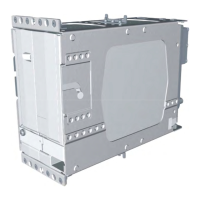190-02692-00 Rev. A
Garmin G100 Pilot’s Guide for the Piper PA-32 Saratoga 83
FLIGHT INSTRUMENTS
SYSTEM
OVERVIEW
FLIGHT
INSTRUMENTS
EIS
AUDIO PANEL
& CNS
FLIGHT
MANAGEMENT
HAZARD
AVOIDANCE
AFCS
ADDITIONAL
FEATURES
APPENDICES INDEX
Figure 2-46 Barometric Minimum Altitude Alerting Visual Annunciations
Barometric
Minimum
Box
Barometric
Minimum
Bug
Within 100 ft Altitude ReachedWithin 2500 ft
Alerting is inhibited while the aircraft is on the ground and until the aircraft reaches 150 feet above the setting
for the alert. If the aircraft proceeds to climb after having reached the minimum altitude, once it reaches 50 feet
above the minimum altitude, alerting is disabled. The function is reset when a different approach is loaded, the
approach is deleted, or when the system power is cycled.
Setting the barometric minimum descent altitude and bug:
1) Press the
TMR/REF
Softkey.
2) Turn the large FMS Knob to highlight the MINIMUMS Field.
3) Turn the small FMS Knob to select the desired altitude source: barometric (BARO) or temperature compensated
barometric (TEMP COMP). OFF is selected by default. Press the ENT Key or turn the large FMS Knob to
highlight the next field.
4) Turn the small FMS Knob to enter the desired altitude (from 0 to 16,000 feet).
5) To remove the window, press the
CLR
Key or press the
TMR/REF
Softkey.
Figure 2-47 BARO and TEMP COMP Minimum Altitude
NOTE: The temperature at the destination can be entered in the REFERENCES Window on the PFD, or
the TEMPERATURE COMPENSATION Window on the MFD. There is only one compensation temperature
for the system. Therefore, changing the temperature will affect both the loaded approach altitudes and
the minimums. Refer to the Flight Management Section for information about applying temperature
compensation to approach altitudes.

